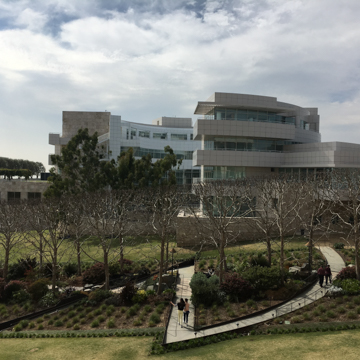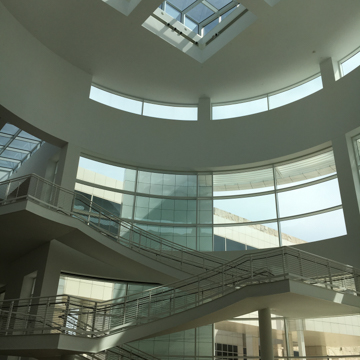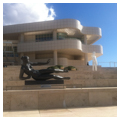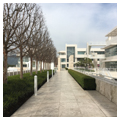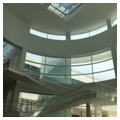You are here
The Getty Center
Perched atop a 110-acre hillside in the Santa Monica Mountains, the Getty Center is situated to frame spectacular panoramic views that span across the Los Angeles Basin from the Pacific Ocean to the San Gabriel Mountains. The Getty Center, designed by Richard Meier and Partners, took thirteen years to complete at a cost of $1 billion. The campus houses the international cultural and philanthropic entities of the Getty Trust and is dedicated to the presentation, conservation, and interpretation of the world’s heritage in the visual arts, and to serving the communities of Los Angeles and the world beyond.
In creating the complex, Meier took inspiration from the setting by working with the topography to situate the buildings along the mountaintop ridge to maximize the views, natural light, flow of indoor and outdoor spaces, and public access according their functions. Throughout the design process, Meier sought to unify nature and culture, and to imbue the site with a feeling that was organic and open, and that embraced synchronistic design opportunities between the Getty and the city grid beyond.
The campus consists of six main structures, which visitors access by trams that ride along the mountain ridge and through the southern California chaparral to the top of the hill. The arrival plaza orients visitors to the campus as all of the buildings, including the J. Paul Getty Museum and the Getty Research Institute, are organized around it. Underground, a system of corridors link the buildings for staff access and facilities purposes. A grand exterior staircase leads from the Tram Arrival Plaza to the plaza level of the complex, where the main entrances to the buildings are located.
The Museum consists of an Entrance Hall with five pavilions beyond it in an expansive space arranged around an exterior courtyard with fountains and lined with Mexican cypress trees. A series of terraces and enclosed and open walkways facilitate the sense of orientation. The layout also offers views of the city framed by the architecture, and birds-eye views of the cactus garden at the south end of the campus and the Central Garden below and to the west. Although none of the buildings are more than two stories above grade, an accommodation to neighboring properties, they appear majestic and even monumental as a result of Meier’s careful site planning, design, and choice of materials.
The facades of the publicly accessed buildings, the retaining walls and bases of all buildings, and most of the ground are covered in travertine—1.2 million square feet in total. The stone was quarried in Bagni di Tivoli, Italy, just outside of Rome, under the careful direction of the architect and his staff. They devised a new “guillotine” process that cut the stone along its natural grain, retaining its rough textured finish and keeping intact naturalized fossils of once-fragile leaves and branches that are now attractions on the facades of the Getty structures. Reminiscent of the solidity of traditional civic architecture and the permanence and awe of ancient temples, the beige-colored stone with honey-colored accents also reflects the dazzling southern California light, bathing the campus in a tactile brightness and warmth.
Curvilinear elements on the buildings interplay with their rectangular and square profiles. In this juxtaposition, the themes of nature and culture, organic and structured, are repeated in the complex’s overall composition. The material used for the curvilinear panels, and on parts of the other buildings not covered in stone, is enameled aluminum finished in off white. The canopy, with a grid pattern heralding the museum’s entrance, is another visual unifier, and it is repeated at the entrance to the Auditorium across the campus. Meanwhile, the curvilinear aspects of the Entrance Hall’s facade soften the grid, while the rotunda inside brings together all the core design elements with its semi-circular staircase, travertine walls and floors, and a flood of natural light from the exterior walls of glass. Allowing natural light into the spaces throughout the campus was an important consideration for Meier. Paintings on the upper level of the Museum pavilions are all naturally lit, with the lighting adjusted by computerized shades and louvers as needed to protect the artwork.
Meier again employs circularity, the theme in the design of the Museum Entrance Hall, in the architecture of the Getty Research Institute on the west side of the campus. This circular building houses a vast visual arts library and archives. Inside, a ramp creates a concentric pathway as it provides access from the top to the bottom floors. Again, walls of glass and a central skylight provide maximum exposure to natural light and views. The form of the building is an incomplete circle with an inviting opening of space facing the Museum pavilions to the east and the sunken Central Garden between them, designed by artist Robert Irwin.
The architecture of the Getty Center embraces modernism in a way that considers the particulars of its function and the specificity of its Los Angeles locality, while uniting the global themes of nature and culture. At the Getty Center, Meier embraced the modernist principles of open space, geometry, and natural light and the use of materials such as aluminum and glass. He fluidly harmonized these with the classical elements of terraces and loggias with composed views, sunken gardens, and stone craftsmanship to create a Getty Center appropriate to its function as a place promoting the heritage of the visual arts.
In 2008, the Getty Center earned Leadership in Energy and Environmental Design (LEED) certification from the U.S. Green Building Council, in recognition of its environmentally responsible design, construction, and operation.
References
Brawne, Michael. The Getty Center: Richard Meier & Partners.London: Phaidon Press Ltd., 1998.
Concert of Wills: Making the Getty Center.Film. Directed by Susan Froemke, Bob Eisenhardt, and Albert Maysles. Los Angeles: J. Paul Getty Trust, 1997.
Meier, Richard. Building the Getty.New York: Alfred A. Knopf, 1997.
Meier, Richard. Richard Meier: The Getty Center.Edited by Toshio Nakamura. A+U (Architecture and Urbanism)special issue (Nov. 1992).
Williams, Harold M., Ada Louis Huxtable, Stephen D. Rountree, and Richard Meier. Making Architecture: The Getty Center .Los Angeles: The J. Paul Getty Trust, 1997.
Williams, Harold M., Bill Lacy, Stephen D. Roundtree, and Richard Meier. The Getty Center Design Process.Los Angeles: The J. Paul Getty Trust, 1991.
Writing Credits
If SAH Archipedia has been useful to you, please consider supporting it.
SAH Archipedia tells the story of the United States through its buildings, landscapes, and cities. This freely available resource empowers the public with authoritative knowledge that deepens their understanding and appreciation of the built environment. But the Society of Architectural Historians, which created SAH Archipedia with University of Virginia Press, needs your support to maintain the high-caliber research, writing, photography, cartography, editing, design, and programming that make SAH Archipedia a trusted online resource available to all who value the history of place, heritage tourism, and learning.











